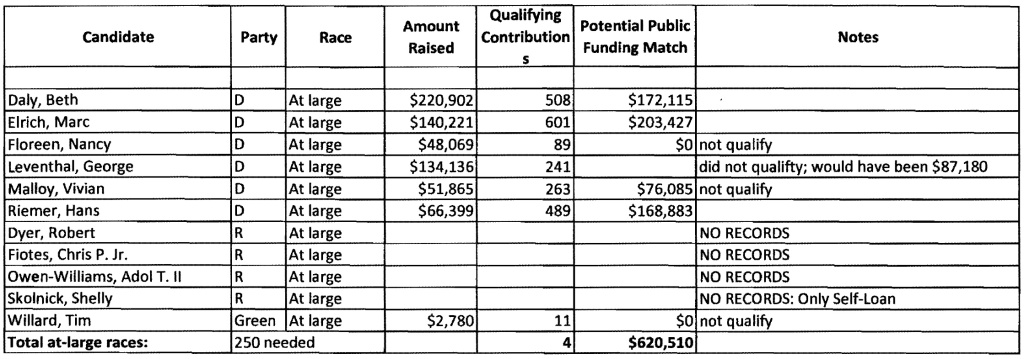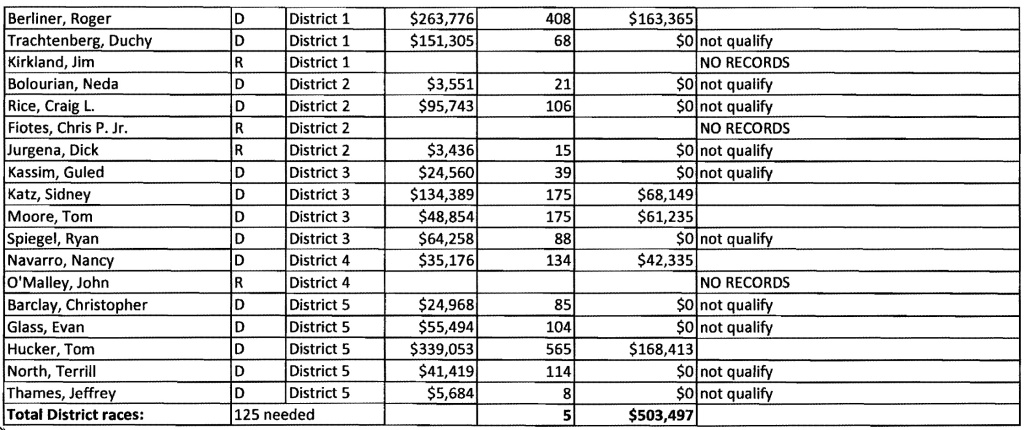The Cost and Impact of Public Financing
Montgomery County has moved closer to adopting a public financing system for county elections with approval of the bill by the Government Operations and Fiscal Policy Committee. As the Council packet explained, the bill proposed by retiring Councilmember Phil Andrews would encourage candidates to raise money in small amounts.
A candidate would need to obtain a specific number of small contributions from a County resident of between $5 and $150 in order to qualify for public funding. Each of these qualifying contributions must be received within 365 days before the primary election and at least 45 days before the primary. A candidate for Executive would need to collect at least 500 qualifying contributions and an aggregate total of at least $40,000 to qualify. A candidate for At-Large Councilmember would need 250 qualifying contributions and an aggregate total of at least $20,000. A candidate for District Councilmember must collect at least 125 qualifying contributions and an aggregate total of at least $10,000.
A candidate for Executive certified to receive public funding would be eligible for a matching contribution of $6 for each dollar of a qualifying contribution for the first $50 of the contribution; $4 for each dollar of the second $50; and $2 for each dollar of the third $50. The match for a candidate for Councilmember would be $4 for each dollar of the first $50, $3 for each dollar of the second $50, and $2 for each dollar of the third $50. . . . The maximum public contribution for a candidate for Executive would be $750,000 for the primary and $750,000 for the general election. The maximum public contribution for At-Large Councilmember would be $250,000 and the maximum public contribution for each election for District Councilmember would be $125,000.
A candidate who voluntarily accepts a public contribution must pay for all campaign expenses with the qualifying contributions, the matching public contributions, and a personal loan from the candidate and the candidate’s spouse of no more than $6000 from each.
But the really interesting part–the impact on the candidate funds–was placed at the far end of the report and has been highlighted in the screenshots at the top of the post. A key caveat in any examination of the Council analysis–and indeed, the point of the system–is that some candidates would change their behavior in response to the new incentives. So take these projections of its impact with a dollop of sour cream.
Would the Bill Achieve Its Goals?
The reason that the presidential public financing system died was the ability of candidates to raise far in excess of the amount available through the system. The rise of expenditures by outside groups and their legalization by the Supreme Court has also contributed to the demise of the system.
Not all candidates would necessarily want to participate in the system. The Council Staff report explained that only two district candidates and one executive candidate could have raised more through the proposed system than they raised without it. On the other hand, three of four at-large candidates could have raised more through the public financing system. Over time, the incentive to participate could decline and even disappear as in presidential elections. It will have no impact on candidates who can afford to self-finance their own campaigns.
Another issue that the bill cannot address is the participation of outside groups. Though the incentives to participate in the public financing system could constrain large donations and the total amount spent, it has no impact on expenditures by outside groups from MCGEO to the Koch brothers.
Moreover, it is not fully clear to me that it would necessarily level the playing field for candidates. In some cases, it might increase the advantage of incumbents or the person who has raised the most money. Challengers or less-well funded candidates might still like it because the initial dollars are the most crucial to viability. The marginal impact of expenditures tends to decline as the amount spent rises.
Some final potential quirky effects. First, potential donors might like if they cannot give such large amounts because they would not be asked to write such large checks. Second, candidates may perversely have to spend more time raising money if they have to raise it in small amounts rather than in large chunks from fewer people. The problem will get worse over time unless the limits are adjusted for inflation, like the federal limits in the Bipartisan Campaign Reform Act (a.k.a. McCain-Feingold).



